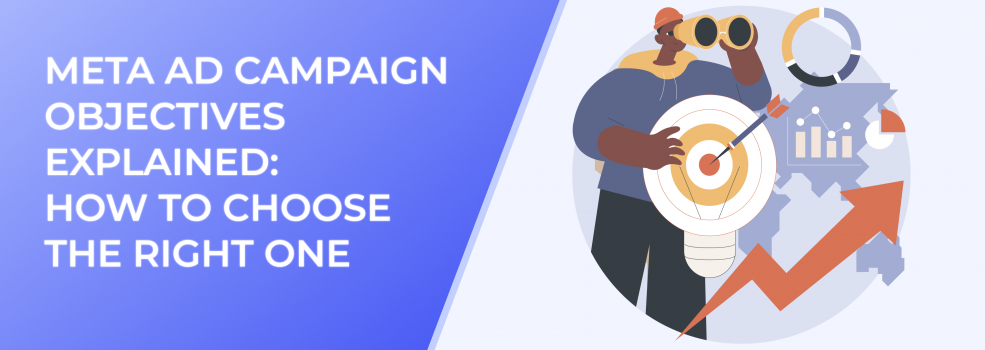Not so long ago, Meta made it easier to set up ad campaigns by simplifying its objectives. The new objectives are broader and transform old options into clearer categories.
This means that you can choose the right objective based on your campaign needs, which is essential for running successful Facebook ads and optimizing them for the best results. But what all these new campaign objectives mean, and when should you choose each of them?
In this article, we’ll cover the following topics:
- What are the main ad campaign objectives on Facebook and Instagram (aka Meta)?
- When to use each of them?
- How to choose the right objective?
By the end, you’ll know how to match Meta campaign objectives to your business goals and improve your Facebook ad performance.
What are ad campaign objectives and why do they matter?
Simply put, an ad or campaign objective is the main goal you want to achieve with your Facebook ad campaign. It determines who will see your ads and how Meta delivers and optimizes them.
This is the first and most critical step in setting up a campaign – your objective will shape the entire campaign strategy. That’s why choosing the right objective is crucial for Facebook ads’ success.
Here are some other reasons why you should carefully choose your campaign objective:
1. Reach the right people
When you choose the right objective, Facebook will show your ads to users who are more likely to take the necessary action: click on your ads, visit your website, make a purchase, install your app, etc.
This helps you focus on the right audience, increasing the chances of success.
2. Use your ad budget wisely
Choosing the right objective also means your budget will be spent where it matters. Meta's algorithms will work to get your ads in front of people who are most likely to convert based on the goals you’ve set.
By targeting only relevant audiences, you avoid wasting money on users who are less likely to engage with your ad, maximizing your return on investment (ROI).
3. Optimize ad performance
Facebook will optimize your ads based on the chosen campaign objective. For example, if your goal is to get traffic to your website, Facebook will show your ads to people who are more likely to click.
With the right objective, your ads perform better because they are fine-tuned to deliver the results you’re looking for, whether it’s conversions, leads, engagement, or something else.
4. Track the right metrics
When your objective matches your business goal, you can track the right performance metrics to see how well your ads are doing. For example, if you want more leads, you can keep an eye on the number of leads and cost per lead. This helps you understand whether your campaign is working or not.
To sum it up, picking the right ad objective is very important for your Facebook ads. It helps you reach the right people, use your budget wisely, and measure the results that matter.
Meta’s new 6 ad campaign objectives: how to choose the right one?
Previously, Meta had 11 different ad objectives, which were split into three stages: Awareness, Consideration, and Conversion. Each stage helped advertisers choose an objective based on what they wanted to achieve.
Here’s how it used to work:
- Awareness: this stage included objectives like Brand Awareness and Reach meant to make people notice your business.
- Consideration: objectives like Traffic, Engagement, and Lead Generation focused on getting users to learn about your product or service and interact with your business.
- Conversion: this stage focused on driving specific actions with objectives like Conversions, Catalog Sales, and Store Traffic.
Now, Meta has simplified this complicated system into six objectives: Awareness, Traffic, Engagement, Leads, Sales, and App Promotion. You might ask: why was this change necessary?
Basically, Meta made these changes to make things easier for advertisers.
First of all, the fewer options there are, the quicker and easier it is to choose the right objective for your Facebook ads. This means a simplified campaign setup.
Second, the new objectives are designed to work smoothly across Facebook, Instagram, and other Meta platforms – they’re optimized for cross-channel advertising.
Finally, now Meta gives better recommendations on how to set up your ad campaigns. When you choose an objective, you’ll get specific advice on how to create successful ads from the start.

Here's how the new Meta campaign objectives correspond to the old ones
In other words, these changes are all about making it easier for advertisers like you to pick the right objective and get better results, whether you’re just starting or running multiple campaigns.
Now, let’s go through each Meta campaign objective and see how they correspond to specific business goals and when it’s best to choose them.
Awareness
The Awareness objective helps you get your brand or product in front of as many Facebook users as possible. This is perfect if your business is new and you’re looking to find the right audience, or you’re launching a product and want to get noticed.
The main goal in this case is to reach a large audience, make them familiar with your brand, and create a lasting impression.
- When to use this objective: use it when you’re introducing a new brand, launching a product, or promoting an event. It’s best for campaigns that aim to build brand recognition rather than making immediate sales.
- Optimization for ad delivery: with this objective, Meta optimizes your ad delivery to show your ads to people who are likely to remember them. This helps you increase brand recall, meaning that people are more likely to think of your brand later on.
- Suggested placements: Facebook Feed, Instagram Feed, Audience Network – these placements are ideal for reaching a wide audience. Facebook and Instagram Stories can work well too.
- Recommended CTAs: ‘Discover,’ ‘Learn More,’ ‘Watch Now’ – CTAs like these invite users to engage without pressure to buy.
- Which metrics to track: focus on Reach (how many people saw your ad) and Ad Recall Lift (how many remember your ad). These show if your brand is getting noticed.
To create effective Awareness ads, use high-quality visuals that capture your brand’s essence – your logo, colors, and style. This will help people remember your brand and instantly recognize it in the future.
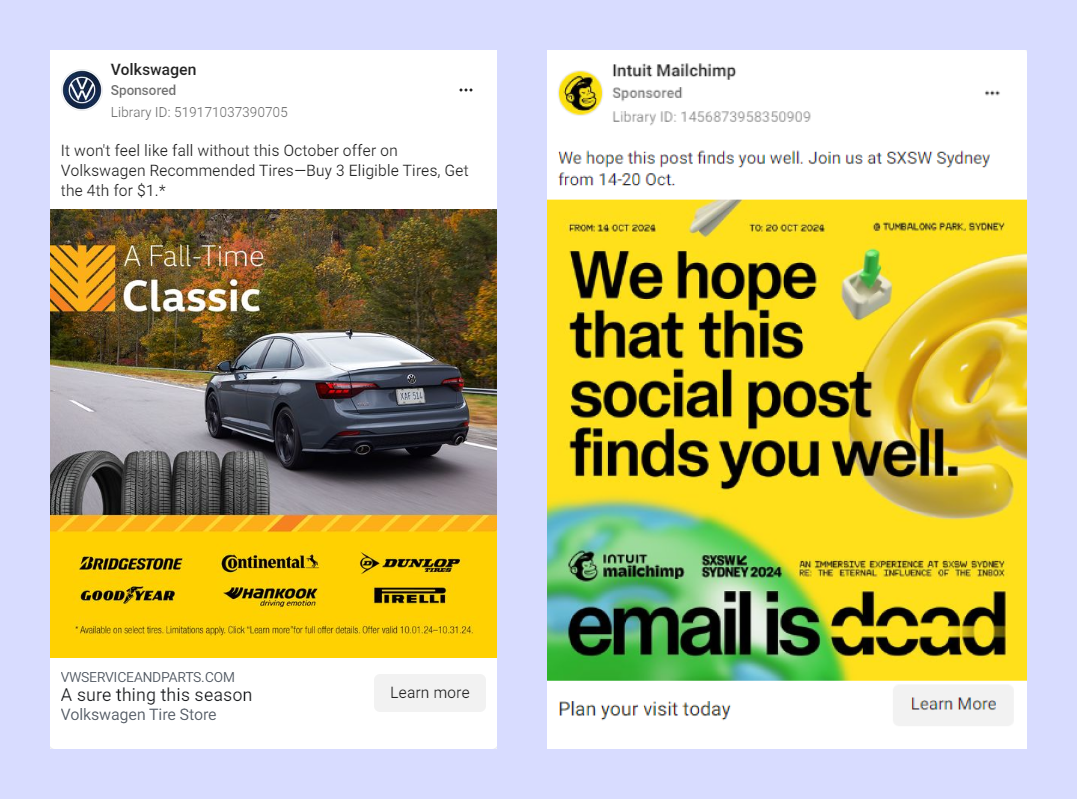
Brand awareness Facebook ads: Volkswagen and Mailchimp
Keep your ad copy simple and focus on what makes your brand or product unique. If you want to attract as much attention as possible, keep it more general – this way, your ad will be relevant to different groups of people. If you want to increase brand awareness for a specific audience, write more tailored copy.
Awareness ads perform well in Stories and Feeds, so consider full-screen visuals with soft calls to action, like "Discover" or "Learn More," to spark interest without pushing viewers to buy right away.
Traffic
The main goal of the Traffic objective is to send people to a specific online destination: your website, app, or landing page. It’s perfect if you want more visitors to check out your website or app and see specific offers you want to promote.
For example, if you’re having a sale on your website, Traffic ads will drive visitors straight to your sale page and raise the chances that they’ll make a purchase.
- When to use this objective: choose it to promote a sale, send visitors to your website or app, or get more people to check out your products and services. It’s particularly useful for sales, limited-time promotions, or driving attention to new launches.
- Optimization for ad delivery: Meta will optimize ad delivery to get more people to click on your ads and visit your selected destination.
- Suggested placements: Facebook Feed, Instagram Feed, Audience Network, Messenger.
- Recommended CTAs: ‘Shop Now,’ ‘Visit Website,’ ‘Get App’ – these CTAs are as straightforward as they come and guide users directly to your destination without extra steps.
- Which metrics to track: pay attention to Link Clicks and Landing Page Views. Click-Through Rate (CTR) can also help you see if your ad is generating interest.
Here, you want to attract not just attention but also action: show off your products or services, explain their benefits, and make sure the destination is clear in both the ad’s image and text – users should know exactly where they’ll end up.
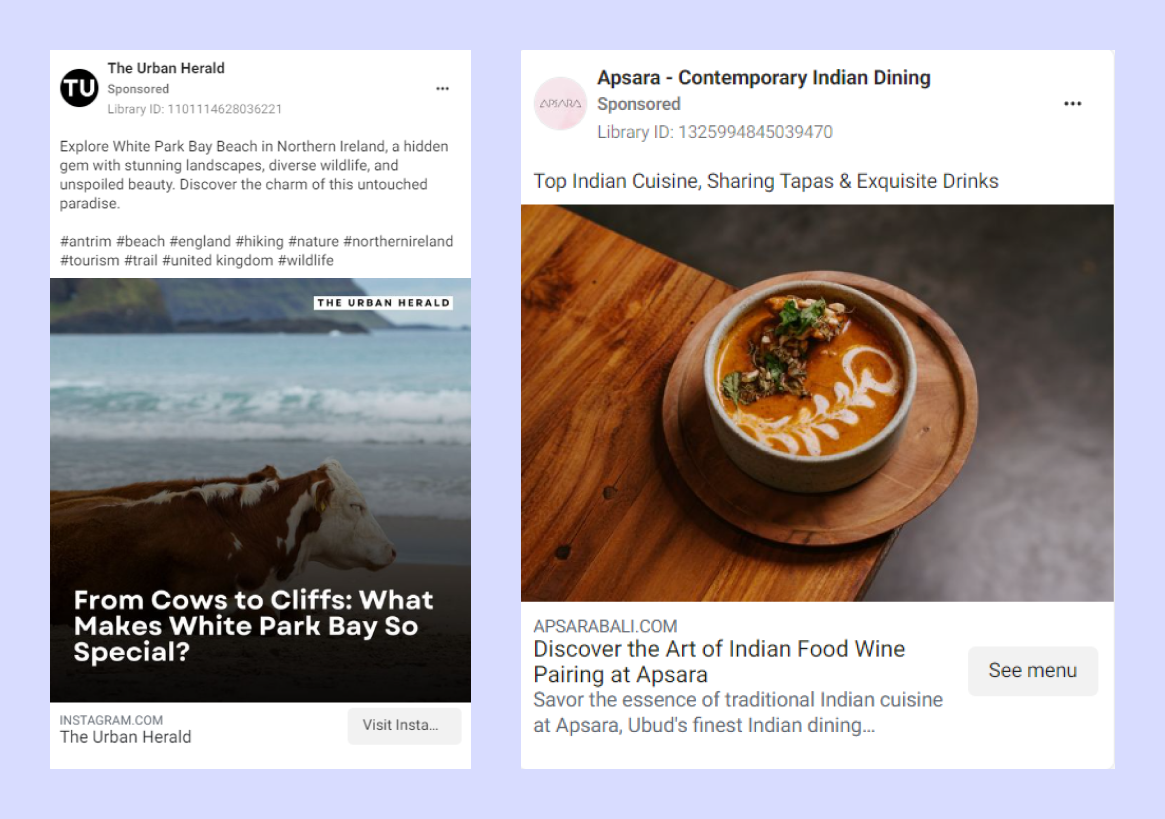
Traffic ads on Facebook: The Urban Herald and Apsara
Including a strong offer or a special deal (especially with an appeal to FOMO) can give users more reasons to click, and a matching and informative landing page helps build trust and convert it to sales.
Engagement
The Engagement objective is all about encouraging people to interact with your content: like, share, comment, etc. This objective helps build community and increase visibility for your posts, which is ideal if you want to strengthen connections with your audience.
- When to use this objective: use it to drive up likes, comments, shares, or responses to your posts. It’s perfect for product launches, special events, or building a community.
- Optimization for ad delivery: Meta will show your ads to active users who are most likely to engage.
- Suggested placements: Facebook Feed, Instagram Feed, Audience Network, Messenger. These placements allow people to quickly like, comment, or share your content, enhancing the chances for engagement.
- Recommended CTAs: ‘Like Page,’ ‘Comment,’ ‘Share’, 'Send Message'.
- Which metrics to track: focus on Engagement metrics (likes, shares, comments), Post Saves, and Page Follows. High engagement shows that your audience is connecting with your content.
Bold, eye-catching visuals and attention-grabbing copies will be your main tool for driving engagement. You can use bright colors or motion to catch attention, show your product in action or a specific scenario that will be relatable to your audience, etc. – there are many options depending on your audience.
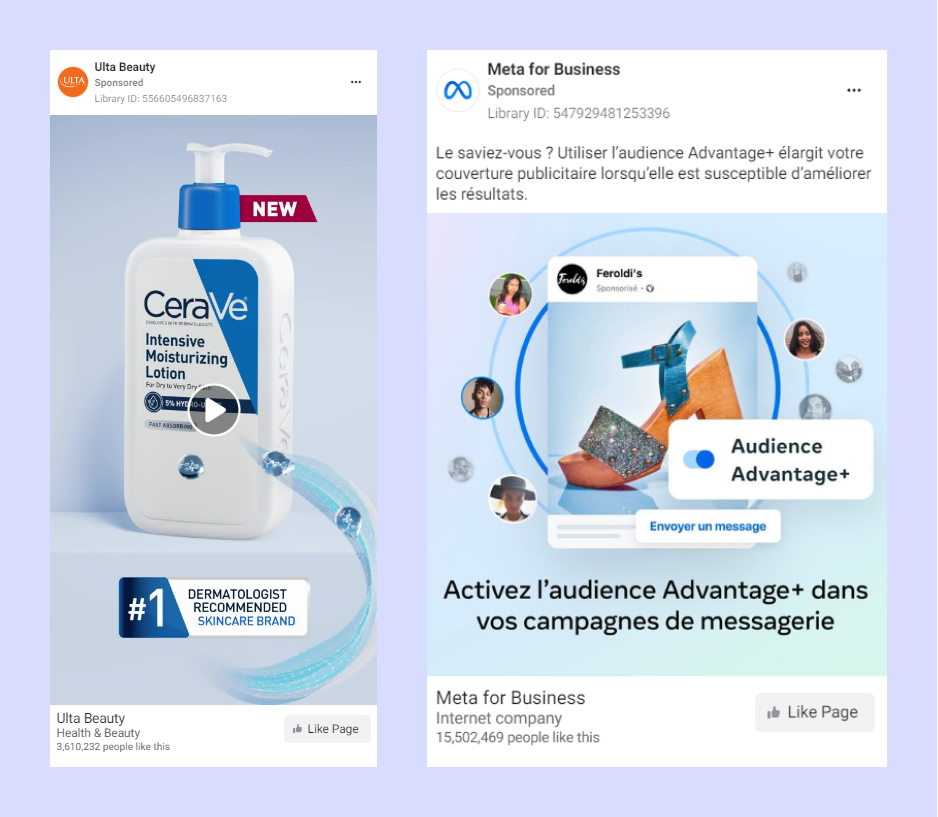
Engagement ads on Facebook: Ulta and Meta for Business
When it comes to ad copy, one effective tactic is to ask specific questions (e.g., “What’s your favorite way to drink coffee?”) to encourage comments and add tags (e.g., “Tag a friend who would love this”) to inspire more shares.
Don’t forget to use casual, friendly language in your copy – you want to come across as an equal to your audience, not just as a brand. Use short sentences, larger fonts, and avoid clutter. Also, always respond to comments to keep the interaction going.
Leads
The Leads objective helps you collect information from potential customers: their emails, phone numbers, and so on. If you want to build a list of people interested in your business for further lead nurturing and retargeting, this is the best objective for you.
For example, If you’re offering a free guide or e-book, you can use the Leads objective to get people to sign up with their email. You can then follow up with them later.
- When to use this objective: use this objective to get newsletter sign-ups, webinar registrations, pre-launch interest, etc.
- Optimization for ad delivery: Meta will help you gather leads through forms or by driving people to sign up on your website.
- Suggested placements: Facebook Feed, Instagram Feed, Audience Network, Messenger.
- Recommended CTAs: ‘Sign Up,’ ‘Apply Now,’ ‘Subscribe’ – the CTAs should be direct, but always counterbalance them with attractive offers. Another good way to collect information about potential leads is to offer them gated content with a CTA like ‘Download’.
- Which metrics to track: monitor Lead Count, Cost per Lead, and Conversion Rate. These metrics show how well your ad is gathering new leads.
To create effective Leads ads, offer something valuable in exchange for sign-ups: a free guide, discount, exclusive access, or anything else that will make people want to give you their information in return for something.
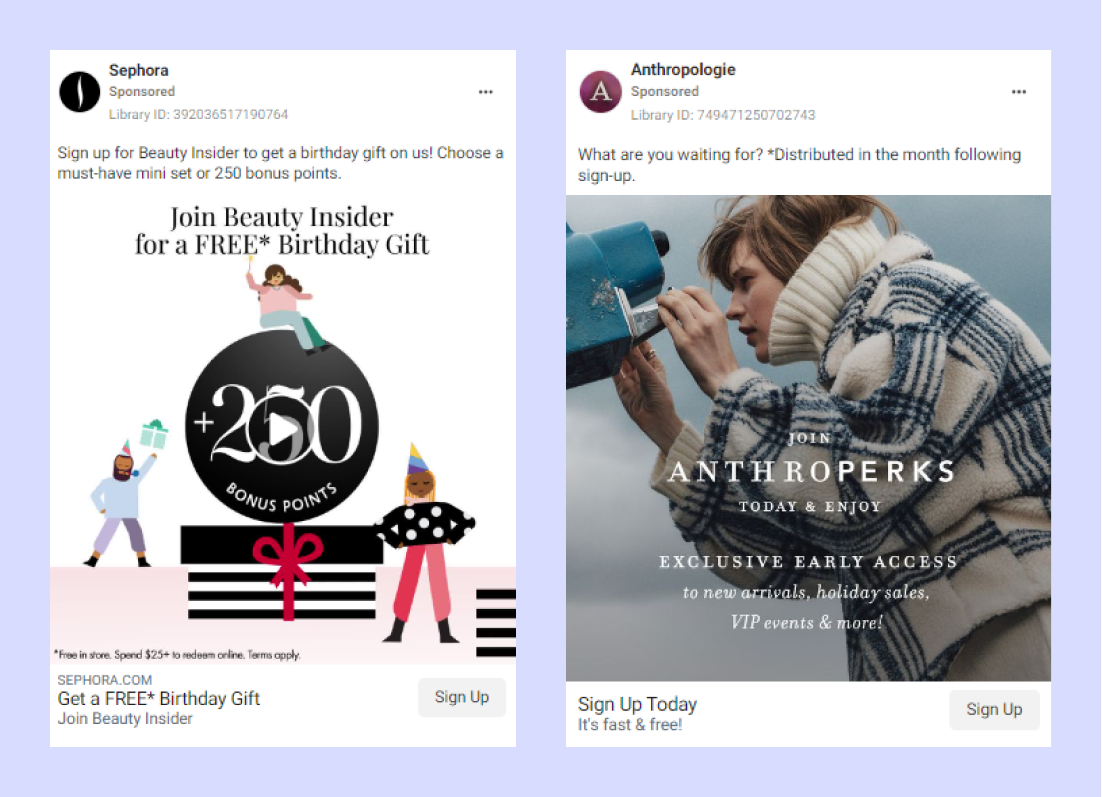
Lead ads on Facebook: Sephora and Anthropologie
Use simple, clear visuals that reflect the offer. It could be a mock-up of your guide cover, a sample of the product, a graph that shows the results your customers can get with your products, etc. Your ad copies should highlight the benefits of what you’re offering, and you can add some urgency to encourage quick action (e.g., “Get Your Free Guide Now!” or “Limited Spots Available”).
Also, make sure people can easily fill out your forms on their phones – optimization for mobile is a must for all types of Facebook ads, Lead ads included.
App promotion
As it’s clear from the name of this objective, its main goal here is app promotion – in other words, to make people download your app, use it more often, or take specific actions in it. This objective is pretty broad since it encompasses practically all goals related to promoting your app, but that’s exactly what makes it the right fit for app-based businesses.
- When to use this objective: choose it to encourage people to download your app or re-engage users who already have it. It’s great for promoting new features, getting more installs, and making existing users subscribe or upgrade.
- Optimization for ad delivery: Meta will optimize your ad delivery to get more app installs or in-app actions, like sign-ups or purchases.
- Suggested placements: Facebook Feed, Instagram Feed, Audience Network, Messenger.
- Recommended CTAs: ‘Install Now,’ ‘Play Game,’ ‘Use App’ – all CTAs related to app promotion. Which metrics to track: focus on App Installs, Cost per Install, and In-App Actions. These show if your app is gaining traction and whether users are engaging with it.
When running App Promotion campaigns, bring your app to life by showing it in action through quality visuals. You can include a quick demo of your app in a video ad, or show its UI in the image format – the main thing is to highlight its best features.
Make the benefits of your app clear: whether it’s saving time, being entertained, connecting with friends, learning new skills, or something else, tell users why they’ll love it. If you have user testimonials or high ratings, use them in your ad creatives to build trust.
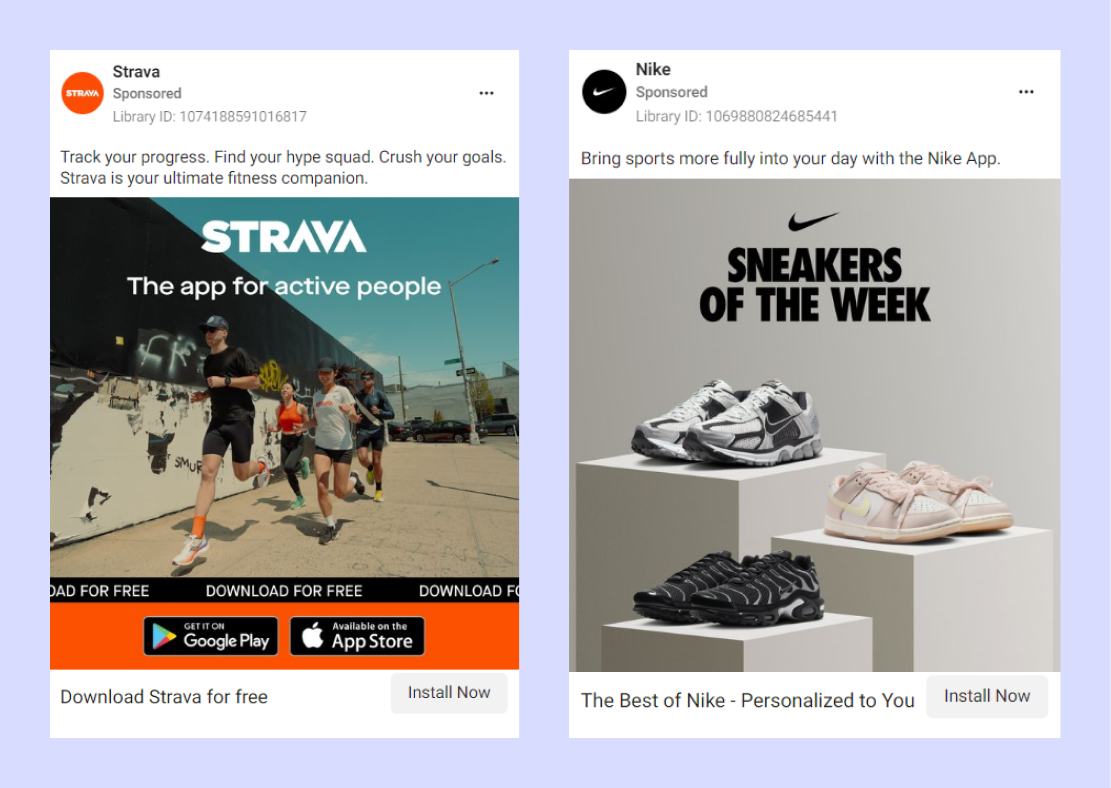
App promotion Facebook ads: Strava and Nike
For existing users, promote special in-app actions like redeeming rewards, and add urgency with limited-time offers. For people who don’t know about your app yet, offer something valuable to make them try it out.
Since most people will see your app promotion ads on mobile, keep the text short and the visuals simple for easy viewing.
Sales
The Sales objective helps you drive conversions: purchases, subscriptions, adds-to-cart, or something else based on your product. If you want to generate more sales or encourage specific actions, this will be the most optimal objective for you. This is especially useful for reaching people who’ve visited your site before but didn’t buy anything – in other words, for retargeting.
- When to use this objective: use it to promote products, new collections, or special deals. It’s great for retargeting customers who have shown interest but haven’t made a purchase yet.
- Optimization for ad delivery: Meta will try to show your ads to people more likely to take specific actions, like buying a product or adding it to their cart.
- Suggested placements: Facebook Feed, Instagram Feed, Audience Network, Messenger. Recommended CTAs: ‘Buy Now,’ ‘Shop Now,’ ‘Order Now’ – here, you can be as direct as possible.
- Which metrics to track: Conversions, ROAS (Return on Ad Spend), and Cost per Conversion will be the most informative metrics here. Metrics like Add to Cart or Checkout Initiated can also show if people are close to making a purchase.
High-converting sales ads are an art in itself; there are many recipes on how to create them, but not all of them work for everyone. The key is knowing your audience, your product, and how to present it to potential customers the right way. For sales ads, you need to use high-quality images that showcase your product in action or from multiple angles. Adding urgency in your ad copy can help you encourage action: phrases like “Limited-Time Discount” or “Only a Few Left” work like a charm, but only when the offers are relevant.

Sales ads on Facebook: Coach and Converse
If you have a catalog of products, try Meta Advantage+ catalog ads (formerly called dynamic ads). They are automatically generated based on products people checked out. This way, you can run a single campaign to drive sales on your website, app, or shop.
Tips on how to organize your ad campaign for better results
Finally, let’s talk a bit about how to organize and run your campaign to make sure you’re getting the best results possible from it.
1. Separate campaigns by objective
Set up one campaign per objective to keep things organized and make it easier for Meta to optimize each campaign based on the specific goal. For example, you can have one campaign for Awareness, one for Traffic, and another one for Sales.
This way, your whole conversion funnel will be covered with just three ad campaigns.
2. Group Ad Sets by audience
Create different ad sets for various audience segments within each campaign. For example, your Awareness campaigns can have ad sets aimed at new potential audiences (you can use Advantage Targeting here) and ad sets aimed at specific groups of people you’re targeting with filters.
In a Sales campaign, you can create a few ad sets to target people who have just visited your site and focus your ad sets on targeting people who are close to converting.
This approach makes tailoring your ads to specific users a lot easier.
3. Tailor your message and visuals
Each objective benefits from a unique and tailored approach to ad creation.
Awareness ads should focus on what your business is all about, using visuals and messages that capture your brand’s style. Sales ads should feature clear offers, like discounts or limited-time deals, and specify why people should pay attention to them. App promotion ads should give people a quick demo of how your app works and its benefits.
In short, there are specific tactics and best practices for each objective, and you can use them to make your ads more effective.
4. Monitor and adjust based on performance
Tracking the right metrics for each objective is a must for properly optimizing your campaigns.
For example, you can track impressions for your Awareness campaigns to check how many users end up seeing your ads, pay attention to the purchases your Sales campaigns get to know how effective they are in attracting customers, and so on.
These metrics will tell you when it’s time to optimize your ads and when their performance is already good enough.
5. Use retargeting for conversions
For Sales and Leads campaigns, retargeting can make a huge difference and help more people move through your conversion funnel.
To retarget effectively, you can show users the products they previously viewed, offer a special deal for those who added items to their cart but didn’t complete the purchase, or those who’ve filled out your lead gen forms, and so on.
This way, you’re connecting with people who already know your brand and giving them that extra nudge to take action.
Final thoughts
Meta’s updated ad objectives make setting up campaigns a whole lot simpler. By choosing the right objective for your goals, you’re making sure your ads reach the right people and drive the results you’re after.
The key to success? Matching the objective with what you want to achieve and following the best practices for each type of campaign: choosing fitting ad creatives, tracking specific metrics, and fine-tuning your ads along the way.
Remember, each Meta ad campaign objective has its focus, so picking the right one from the start makes a huge difference. So, follow our guide, choose wisely, and keep improving your Facebook ads.
